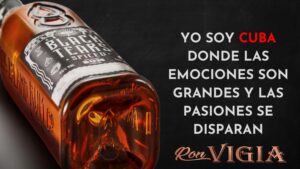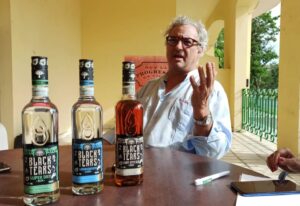Black Tears, contemporary expression of traditional Cuban rum

By Daily Pérez Guillén
There are no reason to shed tears and much less black ones over the good news that the joint venture Ron Vigía S.A. is sharing before the end of 2023. Three years after its first commercial operation, Enrique Arias, its president, spoke with the press about the history that gave rise to four other varieties of rum in Cuba and future plans.
The first spiced rum that has been made on the island is consumed in the national market and is exported to thirty countries under the Black Tears brand, three others (Roble Superior, Super Dry and Aguardiente) are also marketed under this same name and under the historical seal of Vigía. With a musical byword, “it represents everything that is Cuba.”
Around 1.3 billion bottles will be sealed before the end of this year, although according to Arias “there is more demand than production.” A fifth of these bottles have managed to enter the international market. Ukraine receives most of it and the rest lands in the United Kingdom, Singapore, Indonesia, the United Arab Emirates and 25 other countries.
Without forgetting traditions, to create the dry spiced, Enrique listened to the voice of his father, a Spanish connoisseur of rums and with family ancestors linked to Santiago de Cuba. Centuries ago, when these drinks were obtained even purer from sugar cane, other flavors were often used to soften them. What is today the most demanded product of this joint venture emerged from that tradition.

The mixture of three-year-old aged rum, coffee, cocoa and sweet chili (it is called cachucha in Cuba) has given rise to a liquid that is “different, smooth, excellent for mixing dark drinks,” says Arias.
Obtained after two years of formulations, this dry spiced rum found immediate acceptance not only among national consumers, but also among Russian and Canadian tourists who can taste it in the country’s main tourist destinations.
“We visited all the refineries in Cuba for a year, until we found the factory in Falla, Chambas, Ciego de Ávila, where it is produced today. We wanted to make a new rum in an old place and there was a stock of barrels with which we could make an aged rum,” Arias recalls.
In this facility, the investment process foresees about five years of internal reforms to incorporate machinery and create new warehouses. “We could multiply the current capacity by eight and make the production process more efficient, saving energy,” the executive commented.
Although the most desired blessings for Black Tears are expected from young Cuban consumers, their acceptance never ceases to surprise. “It is being widely used in the trendy expresso martini cocktail.”
The brand’s social media confirm what its marketing and commercial director Ramsés Villar shared at the conference: they have achieved a unique positioning after just three years of life in the market and messages designed for their target audience. “No brand of Cuban rum succeeds abroad without first being strong in Cuba. There is also a direct relationship between the success of exports and the markets that send tourists to the country.”

With the same luxury packaging in square bottles and with a contemporary design in which symbols of Afro-Cuban cultures can be identified, a Cuban brandy is also marketed. The effort to “remove the reek but make it smell like sugar cane, like a sugar factory during the harvest, have bouquet and expression ― because spirit is the base of all rum and it has to be tough, but not aggressive” gave rise to the undisputed quality of this variety.
Progresiva Vigía is the other brand with which this joint venture markets its fifth product, a drink that represents the historical experience in creating artisanal rums with a guarantee of superior quality in Cuba. It is made with two base rums aged for different periods of time. One of these “bases” is over 13 years old and provides the woody notes. The liquid is aged in barrels in the “Bodega de añejamiento del tesoro,” in the darkest place, to preserve as much liquid as possible over time.
Established as a result of the alliance between Zerus, the holding company of AZCUBA, and the Spanish company Island Rum Brands SL., the products of Ron Vigía S.A. appeared in 2022 in the International Wine and Spirits Research (IWSR) list, the main database and intelligence on the alcoholic beverages market. Imbued with a creative spirit, its executive said, “they will continue to innovate with Cuban rum and other natural flavors.”

MORE NEWS










